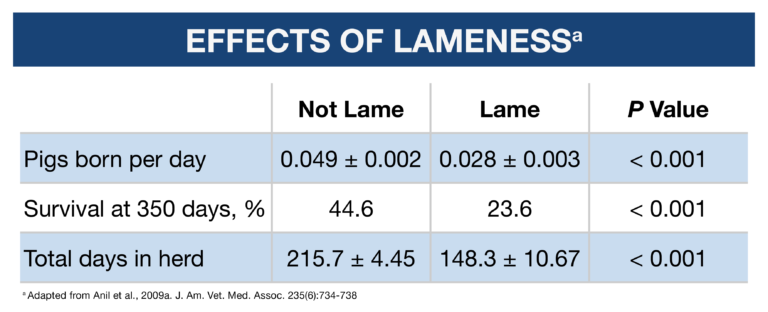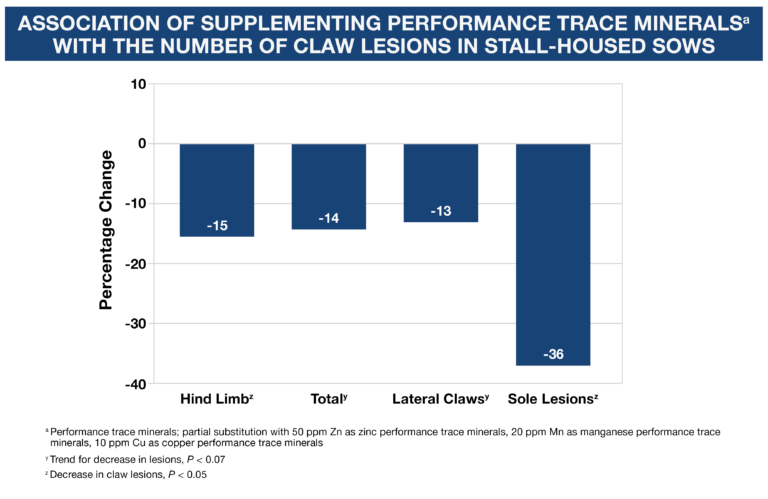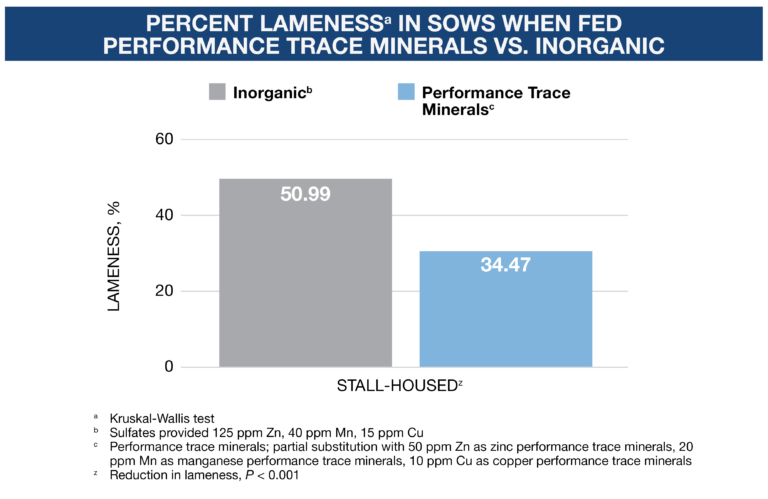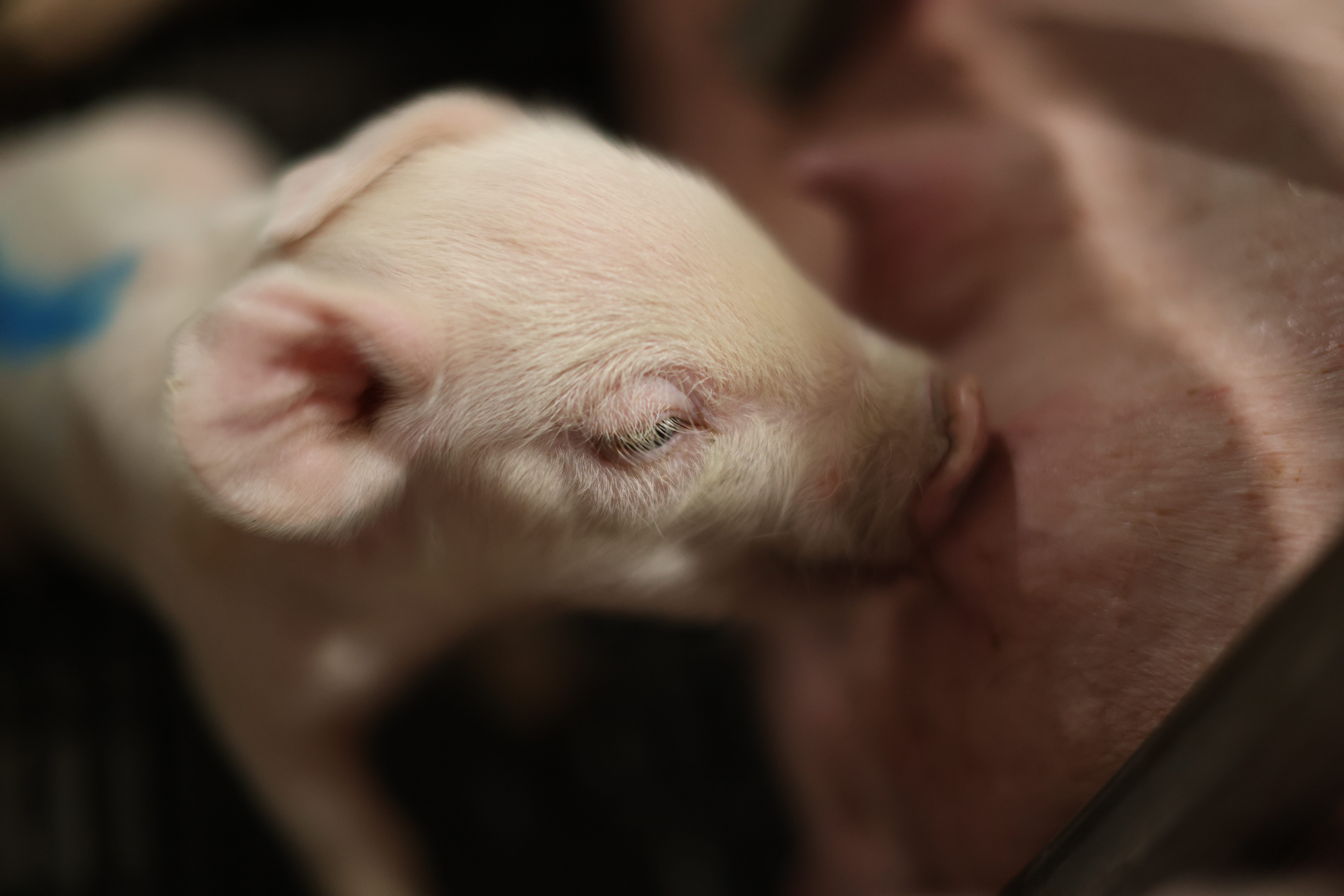When sows are culled at a younger age, it is often due to lameness. Research has been conducted to examine the relationship between lameness and its effects on reproductive performance and sow longevity. The results of these studies show that lame sows had litters of smaller size along with a smaller number of pigs born alive. Additionally, sows had a lower survival rate after reports of lameness and spent fewer days in the herd.

Industry research has also shown that greater than 88% of sows have at least one claw lesion, yet not all lesions are an indication of lameness. The lesions of greatest concern are those which penetrate the horn wall into the corium of the foot causing an inflammatory response (sidewall cracks or white line lesions), as these lesions cause pain and locomotion problems for sows.
Inflammation and Sow Lameness
Inflammation is one of the most apparent consequences of lameness and is an often-misunderstood condition that can have serious animal-wellness consequences. Inflammation is a vital part of the body’s immune response … it’s the body’s attempt to heal itself after an injury (lameness); defend itself against foreign invaders, such as viruses and bacteria; and repair damaged tissue.
Inflammation is a double-edged sword. It’s beneficial when it’s doing the job it needs to do to protect the animal, but it can also cause decreases in productivity, growth, feed efficiency, reproduction and lactation. In the case of lameness, when inflammation or the immune system is activated to help the body heal itself, it uses more energy to fight inflammation, taking away energy that would have been distributed to the reproductive system, thus having a negative impact.
For example, in the presence of lameness and inflammation, feed intake will likely decrease and the sow will not receive an adequate amount of energy and protein. This decrease in feed intake will also reduce the amount of nutrients available for reproduction by decreasing brain signals, hormone output and reproductive performance. Maintaining feed intake and nutritional balance is crucial to sow wellness and overall performance — the key is the supplementation of performance trace minerals into the diet.
Trace Minerals and Their Impact on Reproductive Success
Feeding Zinc (Zn), Manganese (Mn) and Copper (Cu) as amino acid complexes have shown a decrease in claw lesions of sows housed in gestation crates. In a recent study, sows were fed gestation and lactation diets that were identical except for the source of Zn, Mn and Cu.
- Control group — supplemental trace minerals were provided by inorganic sulfate sources as follows: Zn sulfate at 125 ppm, Mn sulfate at 40 ppm and Cu sulfate at 15 ppm.
- Zinpro Performance Mineral group — sows in this group were fed diets containing a partial substitution of the inorganic trace minerals with amino-acid complex minerals from Zinpro at 50 ppm of Zn amino acid-complex, 20 ppm Mn amino acid-complex and 10 ppm of Cu amino acid-complex.
Results indicated that the swine nutrition plan to feed performance trace minerals resulted in fewer lesions on the hind limbs than control sows. In addition, these sows had fewer lesions on the lateral claws and fewer total number of lesions.

The prevalence of sow lameness was lower for the sows fed trace mineral amino acid complexes (34% vs. 51%) over sows fed inorganic trace minerals.

When reproductive performance was evaluated, the sows fed Zinpro Performance Minerals® had more pigs born alive at 11.07 pigs per litter compared to 10.44 pigs per litter. In addition, the sows fed Zinpro Performance Minerals had heavier litter birth weights of 37.45 pounds (17 kg) compared to 35.64 pounds (16.17 kg).
Overall Sow Wellness is Vital to Lower Culling Rates
Claw health is crucial to the overall wellbeing of the sow. If not properly treated, negative claw conditions can lead to lameness and may result in further complications. This causes a devastating loss to swine producers by decreasing reproductive performance and longevity, as well as significantly increasing cost of production.
By improving our understanding of the factors that contribute to sow lameness and inflammation, hopefully we can prevent these circumstances from occurring and avoid the many downfalls of lameness.
Contact Zinpro to learn more about performance trace minerals and their role in helping to prevent sow lameness.

